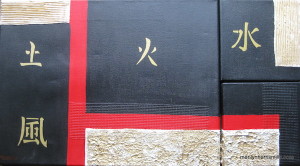~ * ~
This article is written by Marilyn Harris Mills
What is considered good design and good composition?
A greatly debated subject for sure….some consider design to be innovative, cutting edge while others consider good design to evoke emotion with a concentrated colour palette. Who really knows what good design is? Perhaps a subjective matter.
However we judge a good art piece, there are some elements and principles which define a good painting. Whether we design from using our imagination or design from a photograph of our own, some key factors should be considered and applied. You have to teach yourself the basic rules, apply them and then once you’re very knowledgeable then you may go ahead and become creative developing your own style.
The elements of design are the visual elements or tools you use to compose and design. The principles tell you how to use and combine these elements. They help you to organize your composition.
Elements of Good Composition
Let’s first look at the elements of a good composition. These elements should be applied for each painting, whether we are using watercolours, pencils, charcoal or mixed media. Without these elements, our painting is rendered something other than a work of art.
1) Line
Using the correct line within a painting sets the tone of the art. Horizontal, vertical and diagonal, straight, curved, thick or thin can be used. Lines move the viewer into, around and out of your painting. They lead the viewer’s eye and direct it to the center of interest. Using curvy lines will create a more relaxed and casual tone….do we want to stand up and shout or sit and be quiet?! Lines will set the tone. ie think dog fur and the type of breed. A short wiry fur similar to a jack russell fur certainly would look funny on an English sheep dog. In this example the fur compliments the dog breed.
2) Shape
Think small, medium or large for variety. Same sized shapes would be boring. Shapes are organic or geometric. Usually both are included in a painting. Organic shapes are curved, irregular and have a natural feel to them. Geometric shapes are triangles, squares, rectangles and circles. You can paint the shapes either positively, by painting the actual shape or negatively, by painting the space around them. Usually both types of shapes are included into a painting with one being more dominant than the other.
3) Space
Shapes fill spaces. A canvas is a shape itself. You fill this space with shapes to create your painting. The shapes or objects are positive space and the space between and around these shapes or objects is negative space. Both are important. Using shape creates depth in a painting by overlapping them or weaving them together, or laying them side by side. Designing a painting is like putting together a puzzle to create an entire painting.
4) Form
When you draw a circle, once you add form and give it dimension the circle becomes a sphere, a square becomes a cube. So too must you give the objects in your painting, form to achieve dimension. In still life paintings, a direct source of light provides shadows and highlights giving it dimension.
5) Colour
Use a colour wheel if you’re first beginning. Learn about what colours go with each other ie red and green or using a yellow with a purple makes the painting pop. Once you’ve acquired a basic understanding, colour theory courses are a must for the serious artist. The thought by many is that colour is the first design element a viewer will notice and/or remember. Colour speaks first in a painting some say. On the other hand, some may disagree, you’ll need to judge for yourself. If your taste is for pastels, then a bright red incorporated into the canvas will set forth a jungle of nerves for you.
Using colour can make or break a design. If the colours used don’t work together, then forget your whole art piece….another one for the yuck bin. When colours are in competition with each other…they tend to scream at you. When the colours do work together, you’re at peace with the painting.
6) Texture
I love creating texture in a painting and often I find this is the easiest element to achieve. Texture can be actual or perceived. Texture refers to the surface appearance of the objects in the painting. Are we wanting to create a smooth velvety surface such as a piece of satin cloth or a rough aged piece of driftwood or even the skin of an elephant? Texture is fun because it creates excitement, interest in your painting…dynamics is the word I like to use to describe texture. However, don’t use too much texture in a painting, you can over do it!
Stay ARTistically Inspired.
Read Part Two: 6 Principles for Composition in Mixed Media Art
Read Part Three: Composition for Mixed Media Art
~*~*~*~*~*~*~*~*~*~*~*~*~*~*~*~*~*~*~*~*~*~*~*~*~
Marilyn Harris Mills, aka Maer, is a Published Artist, Teacher and Designer, in Ottawa Canada.
You can read about Marilyn at Maer’s Muses. Her art has been published in “Creating Time: Using Creativity to Reinvent the Clock and Reclaim Your Life”
“I work in whatever medium likes me at the moment”-Mark Chagall
~*~*~*~*~*~*~*~*~*~*~*~*~*~*~*~*~*~*~*~*~*~*~*~*~




We would love to hear from you